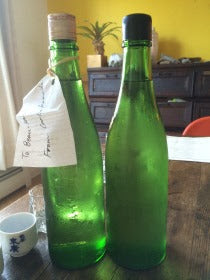Sake Spotlight – Hokkaido’s Carlin Kumada Looks At Taru Sake
What is amazing about the sake industry is the fact that sake souls exist and it is so much fun bumping into one now and again. I bumped into Carlin Kumada years ago, and have been working with him at the International Wine Challenge for the past few years, and think the world of him. He gets it! He is a sake purist, and we are fellow sake retailers. He sells sake in his father-in-law’s shop in Hokkaido and I peddle sake in San Francisco, and our fascination for all things sake is on par!
Not long ago Carlin gave me a bottle of Taru sake that he personally made in Hokkaido, and I slipped it into my super secret sake fridge. So super secret that it was forgotten for a time being (just kidding Carlin). But a year passed so quickly that I did not get a chance to taste it, and then he presented me with another bottle. Doh! So I promised Carlin that I’d taste the sake and then we could compare Taru notes.
I told Carlin that I would get another sake soul and a person who really knew their brews to taste with me. That person came in the form of Tamiko Ishidate – Sake Sales Manager for Young’s Market California – who knows her brews better than most. And we picked a night to taste two green bottles with no labels to speak of. So mysterious!
Tamiko and I started with the older bottle of Carlin’s special Taru sake, which was a little less than two years old. The nose was indeed woody and the sake had incredible length in feeling and flavor. There were dried fruit elements amongst the cedar hues, with a lot of fatness and a deep sugary body. We both felt a lot of glucose in the brew and it was balanced with a nice smokiness that did not translate into too much acidity or woodiness. It was a very solid sake for being a little long in the tooth, and you could tell it was very well made.
The fresher of the two bottles was next, and it had been bottled less than 6 months. The nose was far more ricey and the brew drank more zesty and lively than any taru that I have tasted before. It almost drank like a nama sake, bright frisky and far thinner than the older version, which I now deduced had settled in the bottle a little.
The long flavor of the older version was replaced with a crisp and tingly tighter fluid that drank almost like a sarsaparilla with hints of cinnamon and cedar. It was far more alive and chipper than the aged version and really stood out as a sharp and powerful sake with tickles of cedar and a laser quick sake that pounced on the palate, but did not scream “cedar sake.”
Wow! What an experience, so I immediately fired off an email to Carlin to find out more about the sakes and his motivation to make cedar sake by himself. Herewith are some of the email exchanges with Carlin in his own words and this now becomes his Sake Spotlight on Taru Sake (Taruzake = cedar sake):
- Beau-san I hope you like the Taruzake! It is a bottle that I made in Dec. 2012 It is made using Kikuhime’s Futsu-shu “Jun” (not nama, but I beleive it is a genshu). “Jun” uses special A grade Yamada Nishiki, and is made in the Yamahai style using K-7 yeast. I don’t have any specific data of SMV, san-do, or anything, but I’m sure it all changed in the barrel anyway.
To which I replied:
- What an email!!!! Thank you C!! This is fantastic and I look forward to sharing this in the August True Sake Newsletter - it is so informative and perfect! I think what I will do is a Sake Spotlight featuring you and Taru Sake in general. Do you have any thoughts on Ichinokura's Taru?
Ed. Note: we now carry these great Tarus as well:
To which Carlin had already replied and I messed up the order but you will see the method to my madness. So in Carlin’s amazing words:
- Hey B, sure! I’m a huge Taruzake fan (the good stuff, not the commercially available stuff, but there is a long explanation behind that), so it would be great to help others learn about what make a good Taruzake! Just a couple of clarifications though, the taruzake that I make is made in-store, not at Kikuhime, although the sake that I use, and the barrels are from Kikuhime. Also this taruzake is in no way endorsed by Kikuhime (in that our store takes full responsibility, and liability for this sake), and is not sold by Kikuhime.
With that out of the way, I learned the art of making taruzake from my father in law. The reason that we are using Kikuhime sake, and barrels, is, my father in law, upon deciding he wanted to make taruzake many years ago, searched far and wide (such drama!) for the sake and barrel wood, best suited for making taruzake. He apparently tried sake and barrels from around 10 breweries before settling on Kikuhime. The reason why Kikuhime has such good barrels (this is an explanation I heard from my father in law, that he had explained to him by Kikuhime’s President) is, They use trees harvested from the Kikuhime property, that are then aged for 10 years, to mellow the flavor (using new wood makes horrible taruzake), before being fashioned into sake barrels. Most wood used in sake barrels is only aged for 3~5 years (although five is rare), which gives the taruzake too strong an aroma, and (as I’ve heard from a couple of wine guys) a tomcat pee / truffle aroma.
Aging the wood, allows for the sake to mature in the barrel and develop good depth and viscosity before the barrel aroma gets too strong (leaving the sake in the barrel for too long will give it a varnish like smell, ruining the sake). We currently use 4, “2 to” barrels (2 “to” = 36L), rotating the sake so that they spend time in at least 3 of the barrels. We rotate the barrels because no two barrels are equal, and rotating the sake through them give the finished taruzake a better flavor than keeping it in the same barrel the whole time. We have been using our best barrel (read makes the tastiest taruzake), used for finishing, since 2005 (also the oldest barrel). The sake spends about 9 days in barrel with a room temp of about 32 degrees C (I have never taken a temp reading for the sake inside the barrel, but it is lower than the room temp due to evaporation). The higher room temp helps to increase the rate of evaporation, making the sake in the barrel more concentrated, and helping to better impart the barrel flavors. Due to evaporation 36L go into the barrel, but only about 35L come out. I studied under my Father in law for 3 years before taking over the operation. We have been making taruzake for about 20 years now, and last year I made a whopping 530L.
As for our shop info, We are located in Sapporo, Hokkaido, Japan. The stores name is “Meishu no Yutaka”, and we have been in business since 1901. Our website is: http://yutaka1.com/english/
index.html . I hope that all that makes sense, I tend to be a little scatter brained when it comes to having to write these processes down. I will see about bringing a bottle or two of the 2013 batch with me to London, maybe we can crack a bottle open together!Thanks, I really love making and drinking taruzake, and I am planning on doing a fair bit of experimentation with it as well (aging, trying other sakes, all sorts of fun stuff). I haven’t tried out much of the commercially available taruzakes (we don’t carry them either), so I can’t really tell you anything specific about them. I can tell you one thing for sure though; the way I make taruzake is not commercially viable on a larger scale, so you can bet that they aren’t true taruzakes. As far as I have heard, and seen, most commercial taruzakes just soak staves of woodin the sake while they are in a stainless steel, or enameled steel, tank.
A lot of times they will use new wood to impart the flavor and aroma as quickly as possible. I’m not saying that that doesn’t mean there aren’t good taruzakes out there, or that the above way of making it is wrong (the whole point of making it is to sell it at a profit, and every company is entitled to their profits), but perhaps a bit misleading. I don’t mean to bash any of your sakes, I am just passionate about the subject. I would really love to hear your thoughts and comparisons of my taruzake and the others that you carry, sounds fascinating!
Thank you Carlin, and for the record we did NOT crack the bottle open in London at the IWC. Instead I flew it home and did the comparison tasting mentioned above. Just a quick comment on his thoughts on other taru sakes in general, including the sakes we sell at True Sake. His opinion of how large scale taru sake production is made may or may not be correct. I do not know and as a professional I do not want to speculate, so we wil try to track down the answer.
As per our jizake taru sake offerings I know for a fact that they are barrel aged exactly how Carlin makes his taru sake, but rather then 9 days they are stored for about 2 weeks in cedar barrels that are probably lacking in the quality of Carlin’s barrels which may account for the strength of his cedar and shorter storage time.

In this regard we have some very good offerings that drink very well and in the spirit of Taru Sake. In fact I just did a sake tasting for a major Wine website and the entire team liked the taru offering almost more then the 8 other sakes that I poured for their tasting. If you have never tried a taru I strongly recommend that you do, especially out of a cedar box called a masu!
Please visit Carlin on FB and if you are ever in the Hokkaido area I am certain that he would love to show off his wonderful sake store to one and all.


